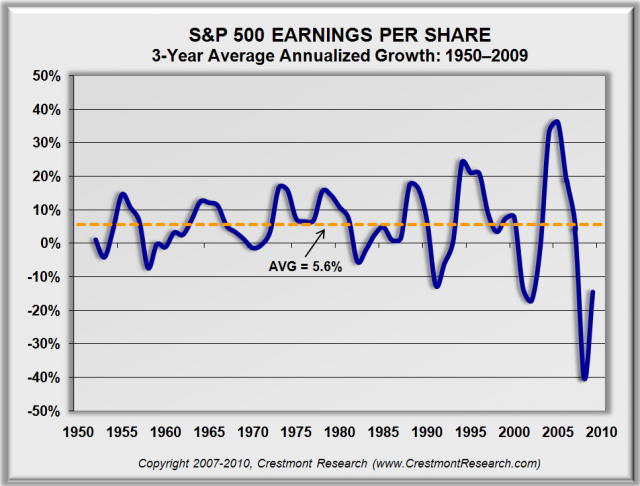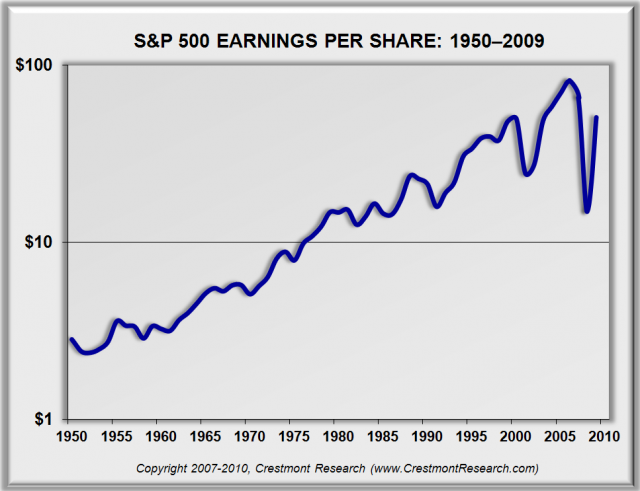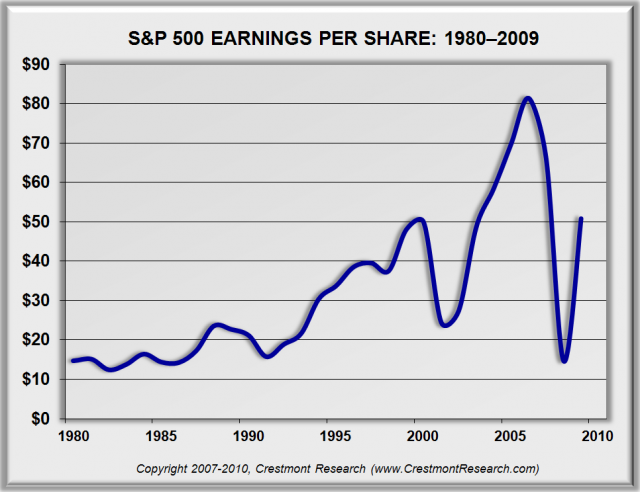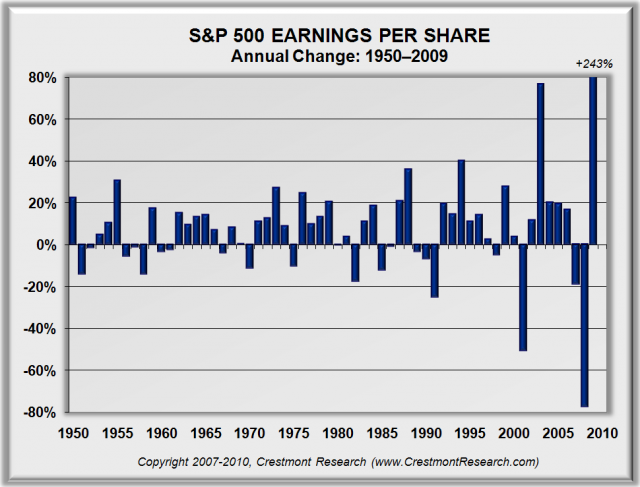History provides insights into the typical characteristics of the earnings cycle. Though statistics about the average growth rate of earnings are helpful for the long run, the business cycle drives periods of surge and stall for earnings growth over shorter periods of one to five years. Even the drama of the descriptive words “surge” and “stall” understates the significant magnitude and short duration of the EPS cycle.
The recent analysis of average growth rate developed a range of values—most of which were in the mid-single digits (below 10%). As a general rule of thumb, the typical annual growth rate for EPS is generally between 5% and 8%.
Earnings have grown over time, just as the economy has grown. During the sixty years since 1950, earnings grew in nearly twice as many years as it fell. The ups and downs were not completely random; rather, earnings followed a relatively consistent cycle of growing handsomely for three to five years before declining for a year or two. When earnings increase, they surge ahead by 10% or more during nearly three-quarters of the years. During the falls, almost half of the years decline by 10% or more. The magnitude is surprising to people who expect a more consistent growth rate over time.
Figure 5.8 reflects the history of annual changes in actual reported earnings over the past sixty years, 1950–2009. Whereas most of the gains occur in relatively short streaks of three to five years, a few have been shorter, and, only one cycle exceeded five years: a six-year run in the mid-1990s. The declines are swift, and generally occur over a year or two; only twice did EPS fall three years in a row.
This choppy, somewhat irregular pattern has endured across periods of war, technological innovation, political issues, and change. To more accurately see the trends, the period of measurement can be extended by a few years to present the cycle as a multiyear average. This will help smooth the ups and downs to reveal a better indication of the underlying consistency of the cycle.
Figure 5.8. S&P 500 EPS Growth Annually: 1950–2009
Figure 5.9 displays the three-year compounded average growth rate for earnings. While still somewhat erratic, the line begins to show the cyclical nature of EPS—and the tendency for it to return to a baseline growth rate. The average line across the swings is horizontal, reflecting the tendency for above-average growth to be offset by subsequent below-average growth. Therefore EPS is relatively anchored to a constant long-term trend line of growth, consistent with the previous assessment of GDP growth.
The next step is to transition from growth in percentages to growth in nominal dollars, the reported measure of EPS. Since the time horizon is relatively long term, the compounding effect reflects the exponential curve that was seen in prior series. The logarithmic scale can again be used to provide a more representative view for long-term compounding series. For shorter periods, say the past thirty years, the standard scale can be used without much apparent distortion.
Figure 5.9. S&P 500 EPS Growth 3-Year Average: 1950–2009

Figure 5.10 presents the longer-term series of earnings per share for the S&P 500 on a log scale. The slope of the sixty-year line in figure 5.10 reflects the relative consistency of earnings growth over the period. Surges and stalls that appear with percentage moves from year to year calm considerably when viewing the series over such a long period.
GDP growth, as the driver of EPS growth, is relatively consistent over time due to the underlying factors of population growth and productivity growth. The EPS cycle revolves around this more muted economic cycle and around its own core baseline trend.
Figure 5.10. S&P 500 EPS: 1950–2009 (Log Scale)

Figure 5.11 focuses on the past thirty years, and highlights the significant variability in the cycle over relatively short periods, yet it reflects a consistent trend over the long term. The contrast of the two views in the figures emphasizes the need to employ techniques that can reliably filter the static of the cycle to reveal a credible and relatively accurate core baseline. Much like the fighter pilot executing a roll, investors need the focal point of an EPS baseline to provide a stable horizon to avoid the distracting gyrating effects of EPS cycles. The next step is to explore several methodologies that normalize earnings across business cycles.
Figure 5.11. S&P 500 EPS: 1980–2009


